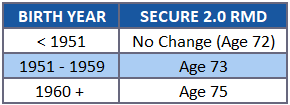SECURE 2.0 – Rethinking Retirement Savings
Jan 11, 2023 • Written by Paul Staib | Certified Financial Planner (CFP®), MBA, RICP®
Blog Home » Retirement Planning » SECURE 2.0 – Rethinking Retirement Savings

From RMDs to student debt, the new law has something for everyone.
Key Takeaways
- The age to start taking RMDs increases to age 73 in 2023 and to 75 in 2033.
- The penalty for failing to take an RMD will decrease to 25% of the RMD amount, from 50% currently, and 10% if corrected in a timely manner for IRAs.
- Starting in 2024, RMDs will no longer be required from Roth accounts in employer retirement plans.
- Catch-up contributions will increase in 2025 for 401(k), 403(b), governmental plans, and IRA account holders.
- Defined contribution retirement plans will be able to add an emergency savings account associated with a Roth account.
The SECURE 2.0 Act was signed into law on December 29, 2022. The legislation builds upon the SECURE Act of 2019 and aims to help strengthen the retirement system – and Americans’ financial readiness for retirement.
The law builds on earlier legislation that increased the age at which retirees must take required minimum distributions (RMDs) and allowed workplace saving plans to offer annuities, capping years of discussions aimed at bolstering retirement savings through employer plans and IRAs.
While SECURE 2.0 contains dozens of provisions, the highlights include increasing the age at which retirees must begin taking RMDs from IRA and 401(k) accounts, and changes to the size of catch-up contributions for older workers with workplace plans. Additional changes are meant to help younger people continue saving while paying off student debt, to make it easier to move accounts from employer to employer, and to enable people to save for emergencies within retirement accounts.
Here are 9 things SECURE 2.0 changes:
For people in or near retirement
1. Big changes to Required Minimum Distributions (RMDs)

- If you were born in 1951 or earlier, your RMD age is unchanged and remains 72. For owners of retirement accounts born between 1951 and 1959, the RMD age is increased to age 73. For people born in 1960 or later, the RMD age has been increased to age 75.
- Starting in 2023, the steep penalty for failing to take an RMD will decrease to 25% of the RMD amount not taken, from 50% currently. The penalty will be reduced to 10% for IRA owners if the account owner withdraws the RMD amount previously not taken and submits a corrected tax return in a timely manner.
- Additionally, Roth accounts in employer retirement plans will be exempt from the RMD requirements starting in 2024.
- And beginning immediately, for in-plan annuity payments that exceed the participant’s RMD amount, the excess annuity payment can be applied to the year’s RMD.
2. Higher catch-up contributions
Starting January 1, 2025, individuals ages 60 through 63 years old will be able to make catch-up contributions up to $10,000 annually to a workplace plan, and that amount will be indexed to inflation. (The catch-up amount for people age 50 and older in 2023 is currently $7,500.)
One caveat: If you earn more than $145,000 in the prior calendar year, all catch-up contributions at age 50 or older will need to be made to a Roth account in after-tax dollars. Individuals earning $145,000 or less, adjusted for inflation going forward, will be exempt from the Roth requirement.
IRAs currently have a $1,000 catch-up contribution limit for people age 50 and over. Starting in 2024, that limit will be indexed to inflation, meaning it could increase every year, based on federally determined cost-of-living increases.
3. Matching for Roth accounts
Employers will be able to provide employees the option of receiving vested matching contributions to Roth accounts (although it may take time for plan providers to offer this and for payroll systems to be updated). Previously, matching in employer-sponsored plans were made on a pre-tax basis. Contributions to a Roth retirement plan are made after-tax, after which earnings can grow tax-free. Important to know: Unlike Roth IRAs, RMDs from an employer-sponsored plan are required for Roth accounts until tax year 2024.
4. Qualified Charitable Distributions (QCDs)
Beginning in 2023, people who are age 70½ and older may elect as part of their QCD limit a one-time gift up to $50,000, adjusted annually for inflation, to a charitable remainder unitrust, a charitable remainder annuity trust, or a charitable gift annuity. This is an expansion of the type of charity, or charities, that can receive a QCD. This amount counts toward the annual RMD, if applicable. Note: for gifts to count, they must come directly from your IRA by the end of the calendar year. QCDs cannot be made to all charities.
5. Other changes for annuities
Qualified longevity annuity contracts (QLACs) are getting a boost. QLACs are deferred income annuities purchased with retirement funds typically held in an IRA or 401(k) that begin payments on or before age 85. The dollar limitation for premiums increases to $200,000 from $145,000 starting January 1, 2023. The law also eliminates a previous requirement that limited premiums to 25% of an individual’s retirement account balance.
For people years away from retirement
6. Automatic enrollment and automatic plan portability
The legislation requires businesses adopting new 401(k) and 403(b) plans to automatically enroll eligible employees, starting at a contribution rate of at least 3%, starting in 2025. It also permits retirement plan service providers to offer plan sponsors automatic portability services, transferring an employee’s low balance retirement accounts to a new plan when they change jobs. The change could be especially useful for lower-balance savers who typically cash out their retirement plans when they leave jobs, rather than continue saving in another eligible retirement plan.
7. Emergency savings
Defined contribution retirement plans would be able to add an emergency savings account that is a designated Roth account eligible to accept participant contributions for non-highly compensated employees starting in 2024. Contributions would be limited to $2,500 annually (or lower, as set by the employer) and the first 4 withdrawals in a year would be tax- and penalty-free. Depending on plan rules, contributions may be eligible for an employer match. In addition to giving participants penalty-free access to funds, an emergency savings fund could encourage plan participants to save for short-term and unexpected expenses.
8. Student loan debt
Starting in 2024, employers will be able to “match” employee student loan payments with matching payments to a retirement account, giving workers an extra incentive to save while paying off educational loans.
9. 529 Plans
After 15 years, 529 plan assets can be rolled over to a Roth IRA for the beneficiary, subject to annual Roth contribution limits and an aggregate lifetime limit of $35,000. Rollovers cannot exceed the aggregate before the 5-year period ending on the date of the distribution. The rollover is treated as a contribution towards the annual Roth IRA contribution limit.

Paul Staib | Certified Financial Planner (CFP®), MBA, RICP®
Paul Staib, Certified Financial Planner (CFP®), RICP®, is an independent Flat Fee-Only financial planner. Staib Financial Planning, LLC provides comprehensive financial planning, retirement planning, and investment management services to help clients in all financial situations achieve their personal financial goals. Staib Financial Planning, LLC serves clients as a fiduciary and never earns a commission of any kind. Our offices are located in the south Denver metro area, enabling us to conveniently serve clients in Highlands Ranch, Littleton, Lone Tree, Aurora, Parker, Denver Tech Center, Centennial, Castle Pines and surrounding communities. We also offer our services virtually.
Read Next
What Happens to Your Health Savings Account (HSA) in Retirement?
• Written By Paul Staib | Certified Financial Planner (CFP®), MBA, RICP®
Health savings accounts get plenty of attention in the financial media and in Washington. Given all the publicity, it may…
Estimating Your Life Expectancy
• Written By Paul Staib | Certified Financial Planner (CFP®), MBA, RICP®
A critically important variable in retirement planning is life expectancy. I occasionally joke with retirement planning clients that if they…
